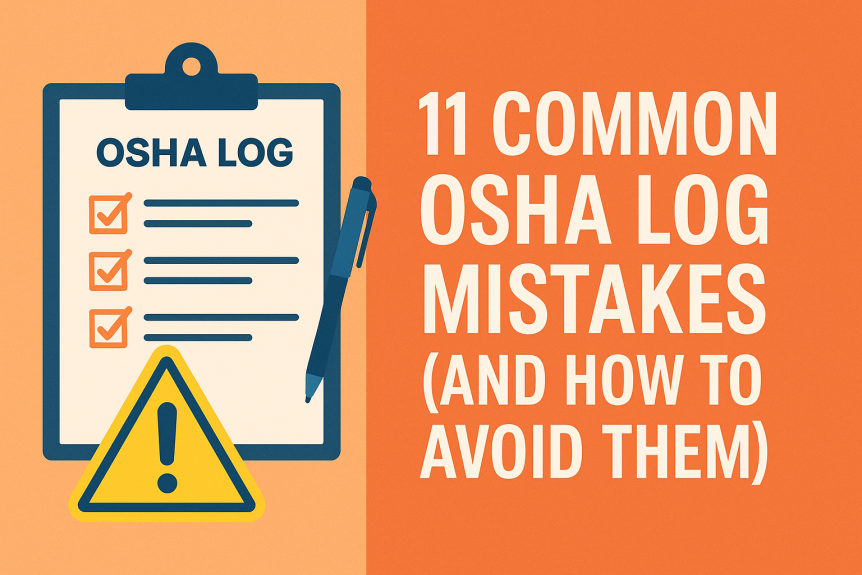Submitting OSHA logs isn’t just another item on your compliance checklist—it’s a requirement that can protect your business from hefty fines, unwanted inspections, and even legal trouble. The tricky part? The rules aren’t always crystal clear, and many companies end up making the same avoidable errors year after year.
If you’ve ever wondered whether you’re doing it right, you’re not alone. The good news is that most OSHA log mistakes come down to simple oversights. By spotting them ahead of time, you can save yourself stress and keep your workplace records in perfect shape.
Here are the 11 most common OSHA log submission mistakes and how to avoid them.
1. Combining All Locations Into One Report
OSHA requires each physical location (also known as an establishment) to submit its data separately. If you bundle multiple sites into a single report, your data will be inaccurate and potentially trigger unnecessary scrutiny.
Fix it: Submit logs by individual location to ensure compliance.
2. Reporting Locations That Don’t Need To
Not every establishment is required to submit logs. Submitting for locations that are exempt only creates confusion and can flag your business for extra attention.
Fix it: Confirm which sites meet OSHA’s reporting thresholds before submitting.
3. Using Company-Wide Totals Instead of Site Data
A common shortcut is plugging in company-wide numbers instead of location-specific data. Unfortunately, that doesn’t meet OSHA’s requirements.
Fix it: Report headcount, hours worked, and other details for each site separately.
4. Picking the Wrong Size Category
Submission rules depend on your peak employment in the previous year—including full-time, part-time, seasonal, and temporary workers. Missing anyone can throw off your classification.
Fix it: Always count every worker, no matter their role, to determine the correct size.
5. Using the Wrong NAICS Code
Your NAICS code determines whether your industry must report. Entering the wrong one can lead to noncompliance or unnecessary submissions.
Fix it: Double-check that each establishment has the correct NAICS code.
6. Logging the Wrong Incidents
Not all injuries or claims should be logged. Many businesses mistakenly treat workers’ compensation claims and OSHA records as identical. They’re not.
Fix it: Familiarize yourself with OSHA’s recordability criteria so you only log qualifying incidents.
7. Missing the March 2 Deadline
The annual deadline for OSHA log submission is March 2. Late entries may result in fines or even inspections.
Fix it: Add the deadline to your compliance calendar and set reminders to file early.
8. Submitting Incomplete or Inaccurate Data
Manual entry—whether on paper or spreadsheets—makes it easy to miss details. Incomplete data can mean noncompliance and misrepresentation of your safety record.
Fix it: Use a digital OSHA recordkeeping platform with built-in accuracy checks.
9. Ignoring Form 301 Requirements
Some industries now need to submit Form 301 data (detailed incident reports). Failing to do so is a costly mistake.
Fix it: Check whether your industry and company size fall under this rule, and include all required information.
10. Leaving Out Your Legal Company Name
Since 2019, OSHA has required that submissions include your official legal business name. Skipping this detail can land you in hot water.
Fix it: Always use your registered legal name when submitting OSHA logs.
11. Overlooking State-Specific Rules
States with their own OSHA programs may require you to submit logs at both the federal and state levels. Ignoring this can result in penalties.
Fix it: Review your state’s OSHA requirements and comply with both sets of rules if necessary.
Final Thoughts
Submitting OSHA logs doesn’t have to be stressful. By avoiding these 11 common mistakes, you’ll not only stay compliant but also save time, reduce risk, and build a stronger culture of workplace safety.
Pro tip: Invest in a digital recordkeeping system to streamline reporting and reduce human error. It’s a simple way to stay ahead of compliance requirements year after year.

